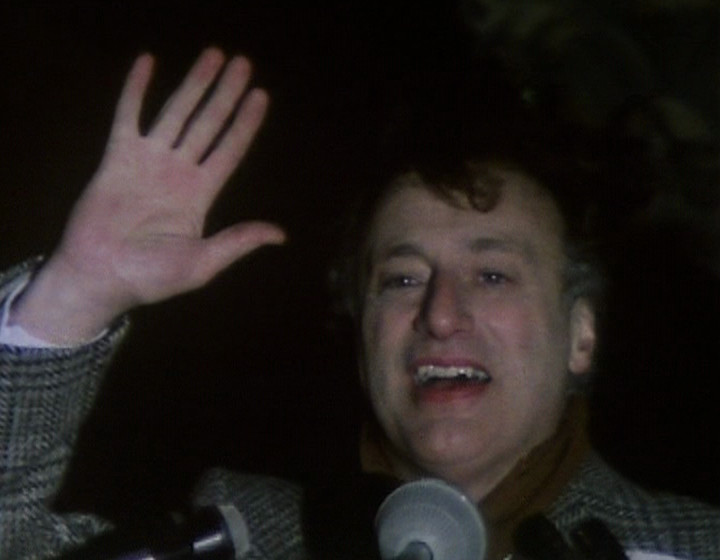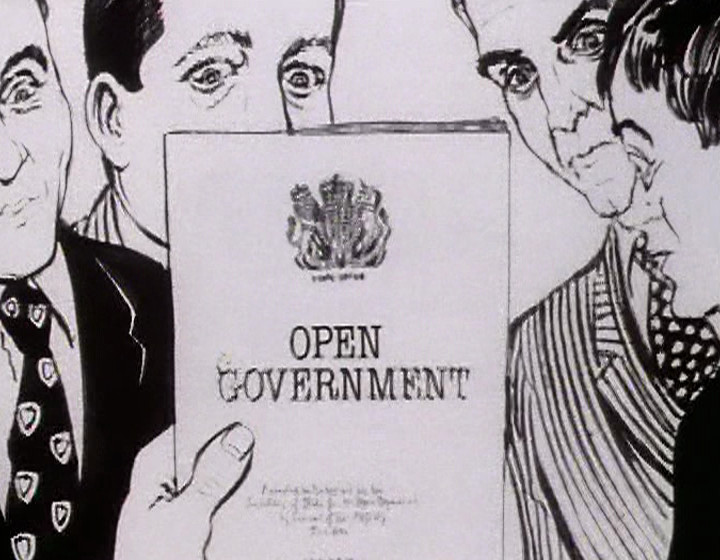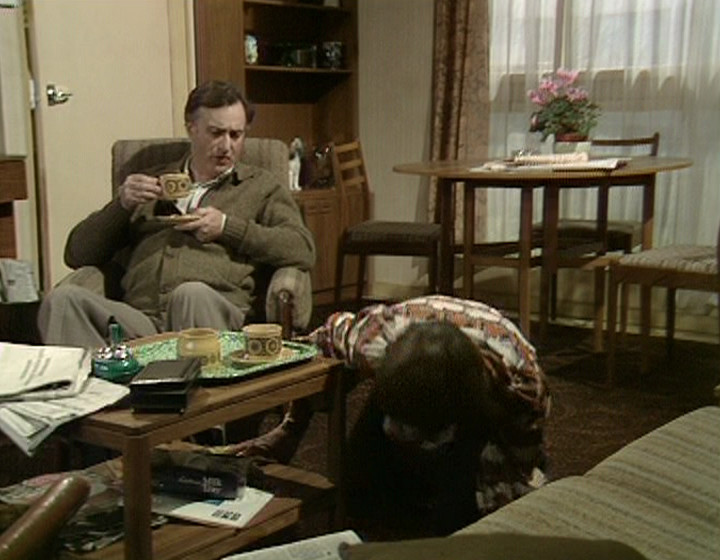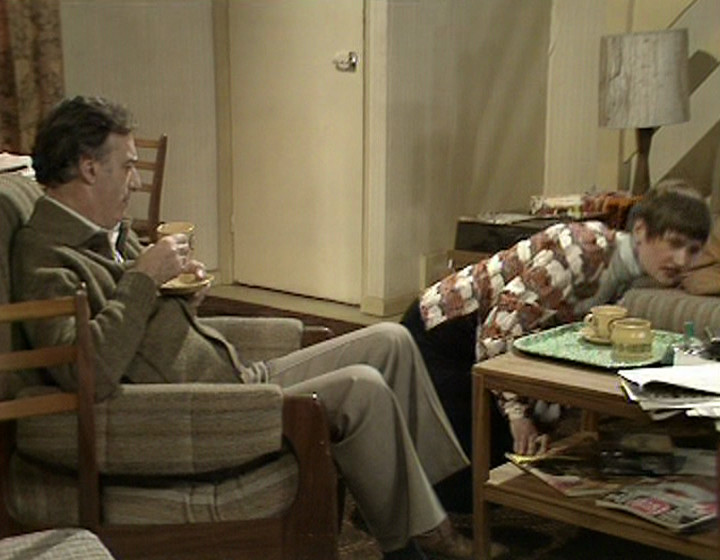When discussing the origins of Yes Minister, one story seems to loom above all: a nervous BBC delaying the series until after the 1979 election. The following version of this tale, told by writer Jonathan Lynn, seems a good a place to start as any. On that pilot recording:
“That Sunday, we recorded the show. I had asserted, with a confidence I did not wholly feel, that it would get laughs. Neither of us1 quite expected the gales of laughter which came from the studio audience that night. John Howard Davies lost little time in commissioning three more scripts, to make the first series of seven. Then we waited, and waited… and waited.
The Winter of Discontent approached and government all but broke down, and the BBC refused to transmit the first series until after the forthcoming election, which turned out to be not until 1979. They were scared that it would be seen as improperly influencing the election. Finally, three years after we had first proposed the show to the BBC, we went on the air in February 1980.”
Jonathan Lynn, “Comedy Rules”, p. 107
Perhaps Lynn can be accused of indulging of some spin of his own here. I’m willing to take him at his word that it was three years since he and Jay had proposed the series to the BBC, but that isn’t the real point when it comes to this particular delay. The heavy implication in the line about the election not being “until 1979” is surely that the pilot was made in 1978; otherwise, why not say “later that year”?
In fact, the pilot of Yes Minister was shot on… the 4th February 1979, a year before it was broadcast on the 25th February 1980. The election clearly caused a delay, but perhaps not for as long as Lynn indicates here.
Still, let’s put all that aside for the time being. Instead, I would like to turn your attention to title sequences. And of course, Yes Minister has one of the all time greats. With music by Ronnie Hazlehurst and visuals by Gerald Scarfe, enjoy this clip, taken from the second episode “The Official Visit”:
Beautiful. But hey, we’ve been talking about the Yes Minister pilot. Why not just take the clip from that, rather than the second episode?
Because, for however long I have known the show and watched it on DVD, I have known the pilot episode to start with the following utter monstrosity instead.
It’s difficult to know where to start, really. Is it the music, which seems to have wandered in from a Brigadier’s sex playlist? Is it the fact that Nigel Hawthorne appears, at best, very ill indeed? Is it the fact that Diana Hoddinott looks like she’s in the wrong kind of Whitehall farce?
Personally, I’m going to go with the following rendition of Paul Eddington, which is frankly just offensive:


How do you trace footage of the actual Paul Eddington, and come up with that? How? Did they splice in some footage of Paul Shane by mistake?
Anyway, these opening titles are a standard joke in my house.2 Which is why, when BBC Four started its repeat run of Yes Minister this month from the beginning, I was looking forward to seeing people’s reactions to it.
Yes Minister starts a repeat run on BBC Four from Tuesday.
Expecting shrieks of horror from people who have forgotten about the pilot opening/closing titles…
— John Hoare (@mumoss) February 21, 2021
So it was slightly bizarre to watch that BBC Four broadcast, and be greeted not with the version of the pilot I’ve watched on DVD all my life, but a version with the standard title sequence used instead. And it was clearly created while the show was still in production, because it has a proper episode title at the end in the correct style, not a bodged-together version made years down the line:

Pilot Opening titles (DVD)

Pilot Opening Titles (BBC Four repeat)
What’s going on? Why did the episode as broadcast on BBC Four look different to the episode I’ve watched on DVD for years?
At which point, something suddenly clicked in my head; and here we go back what I was discussing at the start of this article. The whole thing with this episode is that it was a genuine pilot, not just the first episode of the series. It was made months before the rest of Series 1. But crucially: unlike some programmes, broadcast of the episode was held back, and it first aired alongside the rest of the series.3 Could it be that the episode was never broadcast originally with those shoddy titles, and always had the famous ones added before transmission?
There are two ways to find out the truth. The first is obtaining an off-air recording from 1980, which was always going to be a difficult proposition. The second is to check the paperwork of that initial Yes Minister pilot, and see if it shed any light.
Ladies and gentlemen, I struck gold.

If only all production paperwork was as clear, unambiguous, and told me exactly what I needed to know. That was written like they almost knew what my question was going to be, decades down the line.
And so there is your answer. The general public wouldn’t have been exposed to those awful titles as their first introduction to the show in 1980, like I had assumed all these years. They would have been greeted by the classy version of Yes Minister from the very beginning. The DVD uses the early, untransmitted edit of the pilot, presumably in error.4
* * *
The next natural question, then: are there any other changes between that initial pilot edit as presented on the DVD, and the TX version of the episode?
Of course, the closing credits are different too, but they are in much the same style as the opening titles, and I don’t think you deserve to be exposed to any more of that. Aside from the opening and closing, the vast majority of the episode is absolutely identical… apart from one important change. One film sequence in the show is entirely different between the two versions.
23 minutes into the episode, the written version of Hacker’s speech about open government – “So let’s have some!” – is sent out to the relevant parties. In the original pilot edit, we get a single shot of a bike courier:
The episode as broadcast, meanwhile, has this slightly more involved sequence:
The speech is taken by car this time, but more significantly: we get a close-up of the folder, stating its destination: “PRESS OFFICE, 10 DOWNING STREET”. Clearly, the production didn’t think that the original film sequence told the story quite well enough, and went out and re-shot it. I have to admit, I never thought the original sequence was particularly unclear; indeed, did we even need a film sequence here at all? Surely the story is obvious anyway? Regardless, they clearly cared enough about it to bother with the reshoot.
As for when the reshoot took place, the paperwork helpfully gives the details. The original location shooting for the pilot took place between the 21st – 24th January 1979. The reshoot was done nearly a whole year later on the 16th December 1979, just a couple of months before TX. And don’t you feel better for knowing that?
* * *
Earlier in this piece, I made the rather unpleasant remark about the pilot title music sounding like something on “a Brigadier’s sex playlist”. This is very unkind, although clearly it hasn’t stopped me repeating the insult because it amuses me. But let’s step past the insults, and try to figure out exactly why this music was commissioned. Music that on first listen feels utterly inappropriate.
The key thing to note is that the pilot of Yes Minister was done by experienced director Stuart Allen, who left after this initial show. And there are numerous anecdotes that suggest that the cast and writers were not especially happy with how Allen went about things.
For example, there’s this, from Paul Eddington’s autobiography:
“Both Nigel and I were, however, uneasy about the director. He had made a big hit with On the Buses, a TV series designed to appeal to the most popular taste and which had had a long run. The sophistications of our show did not, I suspect, appeal to him very strongly and he was inclined to fall back on well-tried visual gags. One which particularly jarred was a scene in which Diana Hoddinott, absolutely right as the Minister’s wife, was scrabbling on the floor for tranquillisers. Large close-up of her behind. Wrong!”
Paul Eddington: So Far, So Good, p. 142
I highly recommend you try saying the words “Large close-up of her behind. Wrong!” out loud. It’s great fun.
For the record, in the final programme, Annie isn’t searching for tranquillisers; she’s given up on that, and is searching for cigarettes instead. But far more importantly, there is no close-up of Diana Hoddinott’s bottom to be seen in either the initial pilot edit, or the final TX version of the episode. In fact, her bum remains firmly pointed away from the camera. Not for the first time in an actor’s autobiography, we get half of an interesting story, but the really important bit is missing. Which is really bloody annoying.


For another, slightly more involved tale about Stuart Allen, let’s go back to Jonathan Lynn’s Comedy Rules. This is a fairly long quote, but it seems crucial to understanding exactly what Lynn’s objections were with his directing style.
“Eventually, it was time to shoot the pilot. The BBC engaged the producer/director of On the Buses to direct it. This worried me. All went well at the read-through on the Monday, the first blocking day, and I returned without Tony, who was busy at Video Arts, to see the rehearsal on Wednesday. I was shocked. The script had been rewritten. Paul was now playing a new, silly and bad ‘sitcom’ scene in which he was fussing around choosing fabric for his office sofa.5 At the end of the scene they looked at me for approval. Regretting that Tony wasn’t there to support me, but fairly certain that he would agree, I didn’t mince words. I said that what I had seen was not acceptable and it had to be played as we wrote it.
‘But this new stuff is funny,’ said the director.
‘Not in my opinion,’ I said. ‘It trivialises the whole show. This is not what Jim Hacker is going to be concerned about on his first day in office. The scene was much better and funnier the way we wrote it.’
The director looked at me with skepticism. ‘It’s clever,’ he said with condescension. (It’s interesting how often the English use ‘clever’ as a term of disparagement. Hence the insult ‘too clever by half’.) ‘It’s very clever. But we have an audience coming in on Sunday. We need to get some laughs.’
‘This will get laughs if you play it as written,’ I insisted, though more with hope than certainty.
‘Not very many,’ he said.
‘I don’t agree,’ I said. My heart was pounding, but I stayed outwardly calm. ‘Look, this is the script that the BBC bought, that Paul and Nigel signed on for, and that you agreed to direct. We don’t agree to your changing it. If you do, the show won’t happen on Sunday night. Tony and I will see that it’s stopped. We’ll call our agents today. There will be no show.’ I had no idea of my contractual position, nor did I have any reason to suppose that I had a legal leg to stand on. I was bluffing.
There was a bit of a pause after I uttered this threat. Then Paul said: ‘I think, you know, if Jonathan feels that strongly, we should try it his way.’ Nigel agreed. They started rehearsing the scene again, as it was written. I didn’t leave until they had it roughly right. The director wasn’t happy. I immediately phoned Tony, who, as I’d hoped, reassured me that I’d done the right thing.”
Jonathan Lynn, “Comedy Rules”, p. 105-6
Just to be absolutely clear: I’m not interested in doing a hatchet job on Stuart Allen here. The point with exploring these anecdotes is not to point fingers and call anybody a moron. What seems far more likely is a simple mismatch between director and material. Indeed, Sydney Lotterby, who went on to direct the rest of Series 1 of Yes Minister6, had exactly this experience himself on another show:
“Lotterby was less enthusiastic about being assigned in 1978 to the third series of Some Mothers Do ’Ave ’Em, written by Raymond Allen and starring Michael Crawford as the hapless Frank Spencer, after its first producer and director, Michael Mills, moved to ITV. This time the star was more in control of the storylines and Lotterby failed to appreciate the slapstick humour.
“I didn’t like the physical comedy,” he said. “I prefer more character-based comedy, like Last of the Summer Wine and Porridge.”
Sydney Lotterby obituary, The Guardian, 3rd August 2020
I highly suspect that this mismatch with what Stuart Allen’s view of Yes Minister was, and what everybody else seemed to want it to be, directly informs the original opening sequence of the pilot. Let’s take a look at the paperwork again:

The music wasn’t just a library piece shoved on in the edit; it was specially written and recorded. Moreover, it was specially written by Max Harris, who had a history of working with Stuart Allen, on shows like Mind Your Language.
Let’s now compare the dates. The original theme for the pilot was recorded on the 29th January 1979. The pilot was shot on Sunday 4th February, meaning rehearsal started week commencing… 29th January, the very same day that the theme was recorded. In other words: this theme was written and recorded with Stuart Allen’s original conception of the show in mind. A show which was clearly intended to be slightly more rambunctious than how the series ended up.
So, easy though it is to make fun of that music, we probably shouldn’t. It was, presumably, written to order. It’s not a terrible piece of music really, just utterly unsuited to the final version of the programme. So let’s just listen to Max Harris’ excellent theme to The Strange World of Gurney Slade instead.
I still can’t really forgive the drawings, though.
* * *
In some ways, it’s an absolute delight to have the unbroadcast version of the pilot on DVD, of course. A little insight into the production of the show, which we may well never would have had otherwise. Isn’t that a good thing?
In some ways, yes. I mean, I would be very willing to bet that it wasn’t deliberate. Unless a DVD has a team behind it who really knows what they are doing – Red Dwarf or Doctor Who, for instance – they can tend to suffer from “first off the shelf” syndrome. But without this error, we wouldn’t have the fun of seeing what the initial version of the episode was like. And I’m presuming, if you’ve got this far down this ridiculous article, you also consider this kind of thing to be fun.
Still, it’s worth considering the unintended effects of a DVD release where somebody perhaps didn’t concentrate hard enough. For years, I’ve thought that the world’s first exposure to Yes Minister was different to how it actually happened. Leading to questions like this:
It is thoroughly bizarre they didn't just paste the famous Scarfe/Hazlehurst titles onto that pilot episode.
It was made as a pilot, but not shown separately; it was first seen as part of the first series. Why launch your series with titles you've since decided were crap?
— John Hoare (@mumoss) February 21, 2021
Answer: they didn’t launch with the crap titles. I just didn’t know that.
And it’s not just me, of course. At the time of writing, Wikipedia states the following:
“Scarfe’s and Hazlehurst’s work was not used for the first episode, “Open Government”. The final version of the titles and music had yet to be agreed, and both differ substantially from those used for subsequent instalments. […] The Scarfe and Hazlehurst credits were used for some repeat broadcasts of the first episode, but the original pilot credits were retained for the DVD release.”
And that’s the problem, when DVDs give the wrong idea of how a programme was originally transmitted. Even now, in a world of streaming, DVDs have a tendency to be considered the canonical version of a TV show. The version that’s easily available, the version which won’t suddenly disappear when the rights run out.7 For years, the Yes Minister releases gave a false impression of how one of the most important sitcoms of the 80s was first presented to the world.
Perhaps even more importantly, part of the episode which the production considered unclear enough to reshoot, also ends up being unused on the DVD. All because somebody didn’t really check properly when putting together the discs. And so for years, a misconception was allowed to spread.
So if I can’t change the world in any other way, at least I can clear up this one. The pilot of Yes Minister didn’t go out originally in the version released on DVD. The world wasn’t first introduced to Jim Hacker MP looking like… that.
Tell your friends.
With many thanks to Al Dupres and Paul Bailey.
Lynn is referring to his co-writer Anthony Jay here. ↩
It’s laugh-a-minute living with me, of course. ↩
Hi-de-Hi! and ‘Allo ‘Allo are good examples of shows where the pilot aired separately, long before the rest of their first series. This is easily forgotten these days when watching the shows on DVD or repeats. ↩
One obvious question: what titles were on the VHS release of the show? Alas, I don’t currently have a working VHS machine to check. Can anyone help? ↩
In the final version of the episode, there is a hint as to what it was in the original script which inspired this rewritten scene. At one point, Bernard states: “Oh, we can change anything, Minister: the furniture, decor, office routine. Your wish is our command.” ↩
UPDATE (28/02/21): This article originally said that Sydney Lotterby directed every single episode of Yes Minister. This is not correct, as @jakob1978 points out; he only did Series 1, and then returned for Yes, Prime Minister. Peter Whitmore directed Series 2 and 3 of Yes Minister, along with the 1984 special “Party Games”. ↩
The DVD is often the only version in the correct frame rate as well, but let’s not get into all that today. ↩

10 comments
Lee Barnett on 28 February 2021 @ 1pm
Fantastic piece; many thanks.
Was a huge fan from the moment the show arrived (was studying A-level politics while it was bring broadcast) and I did YM and YPM as my specialist subject on MASTERMIND, so this was like birthday and christmas coming at once.
Cannot thank you enough for an informative, entertaining and wonderful piece..
budgie
Steve Palmer on 28 February 2021 @ 2pm
A thoroughly enjoyable article! Thank-you.
Billy Smart on 28 February 2021 @ 3pm
Very good. One of two Yes Minister articles posted within the same hour today! – https://www.comedy.co.uk/features/comedy_chronicles/margaret-thatcher-sitcom-star/
Inspired by your incisive Tweeting about them, I’ve been rewatching YM/ YPM on DVD myself this last month. There’s one similar credits anomaly in the first Series of Yes Prime Minister. All of the end credits have the same Scarfe cartoon of Hacker as Britannia, except for one of him as a lion. I guessed that this was because two alternate versions were commissioned and the second-choice one was considered good enough to be shown once, rather than an actual mistake somewhere along the line.
Humpy on 28 February 2021 @ 3pm
The originally-commissioned melodic introduction, while inimical to the aesthetically attuned sensibilities of the astute viewer, raises an interrogative debate on the causal sequence and improper copula with a thematically orthogonal production.
Peter Moore on 1 March 2021 @ 9am
The Yes Minister is a fantastic theme tune, ruined by that jarring wah-wah guitar playing incessantly in the background.
John Hoare on 1 March 2021 @ 10am
Billy: I think I subconsciously noticed something different when doing my latest watch, but couldn’t figure out what it was! I might take a peep at the paperwork and see if it reveals anything.
Peter: Not to be deliberately contrary, but I think the guitar is one of my favourite things about Hazlehurst’s theme! I think it would risk sounding a little too stately and pompous without it, which wouldn’t quite suit the show.
Anthony L on 1 March 2021 @ 11am
Great article, thanks – wish the DVD had both versions on, the pilot differences would’ve made an interesting extra.
The VHS release had the titles matching the rest of the series.
Oddly the Ronnie Hazlehurst theme always reminded me of To The Manor Born’s theme, same beats, similar melody, and both around the same era.
David on 1 March 2021 @ 1pm
Fascinating piece, about a misconception I never knew about! Not being aware of any kind of Yes Minister fandom, I didn’t know that there was a belief that the first episode went out with different titles. For twenty years I survived on my off-air VHS copies of Yes Minister (not the original transmission but a 1990 repeat), so I was in blissful ignorance until today. Thank you for a beautifully detailed investigation!
paul freeman on 1 March 2021 @ 2pm
So true about how the wrong director (at least in the sense of wrong for a given project) can skew a show in a particular direction.
I always think how much better ‘Keeping Up Appearances’ would have been in Sidney Lotterby’s hands than in those of Harold Snod, who – it seemed to me – was always more comfortable pushing a performance towards farce.
Robbie on 1 March 2021 @ 9pm
Fascinating article. I was too young to see the original broadcast, so prior to the DVD I’d only seen an early 90s repeat and the VHS, both of which used the later titles and music. So, as a polar opposite, my assumption was that the version on the DVD was an unbroadcast pilot and a happy accident!
Comments on this post are now closed.